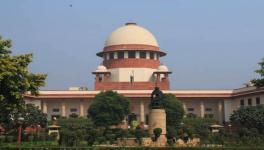Tension Simmers in Baghjan with Compensation not Settled a Year after Oil-Well Blowout
File Photo.
New Delhi: With the government failing to settle compensation claims of those affected by the Baghjan oil well disaster in Assam more than a year after the incident, there has been an escalation in unrest among the local population. Public sector major Oil India Limited (OIL), which owns the now-abandoned oil well where a blowout resulted in a major fire in June 2020, has so far released about Rs 103 crore as compensation to be paid under various categories to affected families.
On July 24, a section of the local population in and around Baghjan in Tinsukia district, miffed over non-settlement of compensation dues, clashed with the police when OIL officials tried to remove equipment from the abandoned site. The clashes resulted in injuries to both locals and policemen. Locals claim that not only have the compensation amounts been measly, but that nothing whatsoever has been done so far towards restoring livelihoods of those affected by the accident. On the other hand, OIL claimed that the compensation amount was released exactly in accordance with the directions of the National Green Tribunal.
“My house is located less than two kilometres away from the oil well. Officials shifted our family to a relief camp when the fire broke out, but we were asked to vacate it after a few days. They paid us Rs 15,000 when we left the camp, saying the amount was for rent, food and other supplies. They further assured us that additional compensation will be paid later on, but nothing has come by so far,” said Joyanta Chorak from Goriating village near Baghjan.
Niranta Gohain of Notangaon, another village within a two-km radius of the Baghjan oil well, told Newsclick that his family had been paid Rs 25,000 when they were was asked to vacate a relief camp to which they had been shifted.
“Only 612 families have been shortlisted for higher compensation. On the other hand, government officials had placed nearly 10,000 people in relief camps. It implies that 10,000 people, maybe more, were affected by the accident. So why is it that only 612 families have been selected for receiving higher compensation?” asked Gohain.
The locals' claims come in the face of figures provided by OIL to the NGT, as per which a sum of Rs 50,000 each was paid to all families who had been taken to relief camps, at the time they left the temporary shelters. The public sector company has further claimed that it had incurred an expense of Rs 11 crore in maintaining the relief camps.
Discontent is writ large among locals in the Baghjan area because of the absence of a concrete assessment of families eligible for higher compensation on account of having suffered losses in the oil-well blowout and the resultant fire. Several rounds of tripartite meetings between local villagers, the OIL management and the Tinsukia district administration have not resolved claims for higher compensation and grievances.
The district administration of Tinsukia had identified 173 families eligible for a compensation of Rs 25 lakhs each, and 439 families for receiving a sum of Rs 20 lakh each. An eight-member expert panel constituted by the NGT to assess losses from the Baghjan accident and identify families eligible for compensation had agreed to the proposal. But OIL had accepted this mechanism only for 600 families, that too with reduced compensation amounts – Rs 15 lakh each for 161 families and Rs 10 lakh each for 439 families.
Earlier, in a report submitted to the NGT in July 2020, the body's expert committee itself had recommended interim compensation to be paid in three categories: Rs 25 lakh, Rs 10 lakh and Rs 2.5 lakhs to persons whose houses were completely demolished, severely damaged and partially damaged, respectively, in the accident, thereby causing grave injuries to life and health, loss of livelihood, cultivable land, livestock and damage to standing crops, horticulture and fisheries. Further, this compensation, as decided by the committee, was to be cleared within 45 days.
Notably, all the families eligible for receiving higher compensation are located in Baghjan alone, even though locals in nearby villages, including those living in Goriating, Hathibat, Motapung and Gotong, have also claimed to have suffered loss of livelihoods from the accident. The tribunal itself had recused itself from entering into any further adjudication over determination of compensation, due to lack of authentic data.
“While floor level compensation can be directed to be paid even on some guesswork, higher compensation claims require adjudication, based on evidence of loss. As already observed, in absence of relevant data, we are unable to determine the claims for higher compensation, beyond the amounts already paid or conceded by the OIL,” the tribunal stated in its final judgement in the Baghjan matter in February this year..
Meanwhile, OIL itself has denied having any role in the determination of the numbers of affected families, or the amount of compensation to be paid to each of them. On the other hand, the hydrocarbon exploration agency claimed that it needed to remove its equipment from the abandoned oil well since it was incurring losses on account of rent being paid against it to contractors. It was during the process of removal of equipment on July 24 that unrest had broken loose.
“The responsibility of identifying the families impacted by the Baghjan incident, as well as the amount of compensation to be paid to them does not lie with us, but with the office of the Deputy Commissioner of Tinsukia district. We had released an amount of Rs 102.59 crore in all towards compensation, even before controlling the fire, in accordance with the interim orders of the green tribunal,” said OIL spokesperson Tridiv Hazarika.
According to the Tinsukia district administration, the actual survey of damages to households caused by the accident was completed in October last year. These records are at present being digitised with the help of the National Informatics Centre. So far, out of the 612 families identified by the administration, compensation amounts of Rs 25 lakh each has been paid to 12 families whose houses were completely gutted in the fire, while Rs 15 lakh each has been handed over to 161 families against lesser damages caused to their dwelling units. The rest of the families identified were paid a sum of Rs 10 lakh each. But the numbers of those claiming compensation are several-fold more. With any fresh survey unlikely to be conducted, the only option that seems to be left with the aggrieved families is to challenge the list of families identified as eligible for compensation by the administration.
“In any case, the administration will submit the list of compensated families to the green tribunal and the state government once digitisation is complete. Thereafter, we will act in accordance with orders received on further compensation payments. We have also offered free legal aid to anyone who wants to appeal in the HC as being eligible for higher compensation. In several rounds of tripartite meetings that have been held so far it has been mutually agreed upon that OIL will be allowed to carry on with its operations and activities, while settlement of compensation dues will also be simultaneously dealt with. Anyone attempting to disrupt law and order, as had happened on July 24, will be dealt with sternly,” Tinsukia Deputy Commissioner Pawar Narsing Sambhaji told Newsclick.
The scale of disaster of the Baghjan oil well accident was unprecedented, as has been noted in several studies conducted over the past one year. It caused large-scale damage to the lives and livelihoods of the local population, far beyond the numbers of families selected for compensation. The eight-member NGT expert panel, which was headed by retired Gauhati High Court judge, Justice B.P. Katakey, had noted this in one of its interim reports:
“In the interim, the Committee is also of the unanimous view that the well Baghjan-5 blowout and subsequent explosion has led to extensive damage to both the publicly owned resources including the Maguri-Motapung wetland, DSNP [Dibru Saikhowa National Park], the eco sensitive zone including the water bodies, air, wildlife and the natural resources surrounding it. Additionally, it has caused irreparable physical harm and damage to privately owned property of the survivors in the affected villages.”
Another study conducted by a team led by fisheries biologist Dr. Ranjita Bania had stressed on the need for a wider survey to exactly identify the extent of loss to locals.
“The sudden shock, oil cover and change in dissolved oxygen level have caused death of large number of fishes … Majority of the fisher who earn on an average minimum Rs. 2000/- per day has to stop their main occupation upto 3 months. This revealed that heavy loss of the local fisher community in their livelihood and will suffer till the restoration of the Maguri-Motapung Beel … due to the blockage of pool first pool from BGR 5 towards Notungaon, Baghjan village is suffering from water logging situation causing damage to their remaining crops … There is a need for survey to cover all the households in Dighaltarang Tea Estate, Baghjan Beel line, Guijan Ghat and other areas to assess the damage due to the blow out incident (sic),” the team stated in its report.
The livelihoods of the majority of the population living in Baghjan is intrinsically dependent on the local ecology. Apart from paddy cultivation, other sources of livelihood in the region includes betel nut cultivation, small tea estates, fishing and animal husbandry, including cattle and ducks.
“The local population cannot get all this back until the ecology of the area is restored. And, till date, nothing at all has been done towards the restitution of the environment. Toxic concentrates of gases released from the blowout and the fire have affected local farmlands and vegetation. Underground water tables and other water bodies, including the Maguri-Motapung wetland, have been contaminated by the oil. Imagine the impact of this on animals,” Bornani Kakkar, who had filed the petition in the green tribunal, told Newsclick.
“The health impact on local people and wildlife has also to be taken into account. Several people have complained of hearing impairment and other ailments from the deafening noise that engulfed the entire region continuously for nearly six months after the oil well caught fire,” Kakkar added.
However, it seems unlikely that the issue of restitution of environment will be dealt with anytime soon. A ten-member committee, with the objective of assessing damage done to the local ecology and restoration of the Dibru Saikhowa National Park and Maguri-Motapung Wetland, was formed by the green tribunal in its final judgment issued on February 15, 2021. However, the Supreme Court took exception to the fact that the Managing Director of OIL, the public sector firm whose very conduct in the Baghjan accident is in question, was also on board this committee. In an order issued on July 1, therefore, the apex court imposed a stay on the operation of the green tribunal’s order.
Meanwhile, the Assam government has prepared an inquiry report into the ecological damage caused by the accident in Baghjan. The report, titled Ecology and Economy: Lessons Learnt from Baghjan Blowout, prepared by the state Additional Principal Chief Conservator of Forest and Chief Wildlife Warden, M.K. Yadava, has pegged the estimated loss from the accident at Rs 25,000 crore. The report further claimed that around 55% of the biodiversity in the area was destroyed in the accident. Though this report, finalised in June 2021, has been submitted to the Assam government, any action on it is yet to be taken.
The writer is an independent journalist.
Get the latest reports & analysis with people's perspective on Protests, movements & deep analytical videos, discussions of the current affairs in your Telegram app. Subscribe to NewsClick's Telegram channel & get Real-Time updates on stories, as they get published on our website.
























